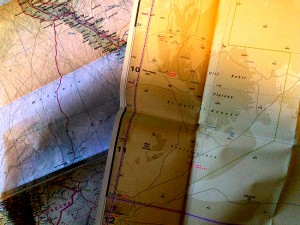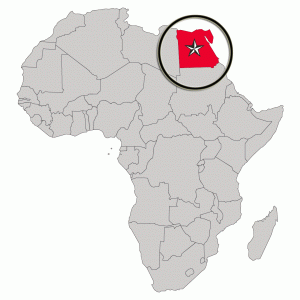
WESTERN DESERT, EGYPT (31 March 2018) — Even though I had read that “Crystal Mountain” wasn’t a mountain, on first glance I was a bit disappointed that it was not more dramatic. Somehow I still expected a sparkling glass-like entity rising up from the desert sands. Instead it seemed to be more of an ordinary looking ridge formation, not terribly distinguishable from the rest of the desert. Then as I took a walk, I began to see and understand the hidden magic.
All the crumbling rocks on the “mountain” are made up of delicate “crystals,” that shimmer in the sand. I climbed up and around, being careful not to “break” off any of the pieces. This was the perfect example of how the desert can be harsh and fragile at the same time. The desolate landscape and rough-hewn profile hide the delicateness of mother nature’s art.
I am not sure of the geological explanation for this oddity, but it fascinated me as I continued to explore it. Some say it is calcite crystal others say it is quartz. The “crystals” are semi-transparent white-ish rectangular pieces, and in my imagination they seemed like rough diamonds.
I am learning that the Western Desert has many secret places (well not exactly “secret” but let’s say “hidden”) within its vastness, and we are only on its edge. I already know that I will have to return here with much more time to explore deeper. The area we are covering in these few days only really became “interesting” to foreigners after the discovery of the “Valley of the Golden Mummies” in the mid-1990s, when the people of Bahariya and Farafra began doing Jeep Safaris along this route for tourists. Traffic fell off dramatically when the regional security situation became an issue, though I am unsure whether that is because less people wanted to come or because the Egyptian security forces would not allow it. Much of the Western Desert is still off-limits, and while Abdou and his friends hope it will “re-open” soon, no one is counting on it. For the present we will have to be satisfied with what is possible. And so far, it is an wonderful introduction…

ABOUT THE EXPEDITION

JoMarie Fecci, of USnomads, sets off on an independent scouting trip across Egypt and Sudan in preparation for an up-coming Sahara expedition. Driving locally-sourced Toyotas and working with small local teams in each region, she will traverse a winding route that jumps off from key points along the Nile as far south as Khartoum, where the Blue and White Niles meet. During the journey she will visit a series of UNESCO world heritage sites focused on the ancient civilizations that occupied the region and meet with local communities. The primary goal of this mission is to assess terrain, security, driving conditions, logistical concerns and approximate timeframes for future travel.
WHERE WE ARE

The Arab Republic of Egypt, is a transcontinental country spanning the northeast corner of Africa and southwest corner of Asia by a land bridge formed by the Sinai Peninsula. With the Mediterranean sea on its northern border, the Gulf of Aqaba to the east, and the Red Sea to the east and south, it occupies a geo-strategic location connecting Europe, Asia and Africa. It has land borders with Gaza and Israel to the east, Sudan to the south, and Libya to the west. Islam is the official religion and Arabic the official language. Egypt is the most populous country in North Africa and the Arab world, with over 95 million inhabitants. Most of the population lives near the banks of the Nile River, in an area of about 40,000 square kilometres (15,000 sq mi), where the only arable land is found. The large regions of the Sahara desert, which constitute most of the country’s territory, are sparsely inhabited. Considered a cradle of civilization, Egypt emerged as one of the world’s first nation states in the tenth millennium BC and iconic monuments such as the Giza Necropolis and its Great Sphinx, as well the ruins of Memphis, Thebes, Karnak, and the Valley of the Kings, reflect this legacy.